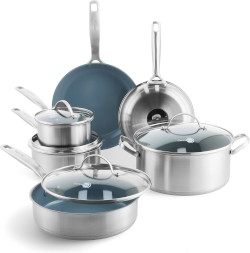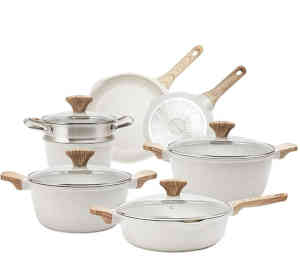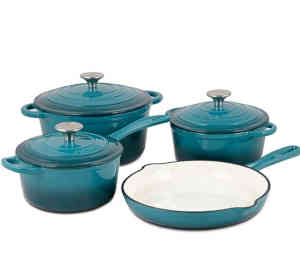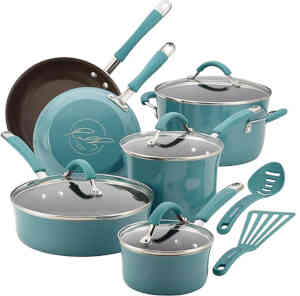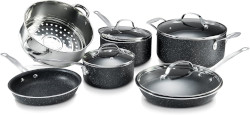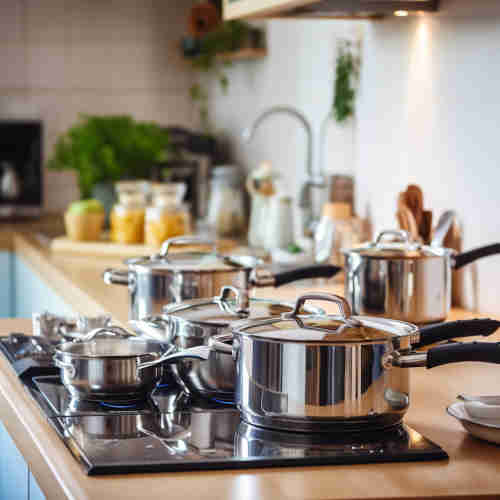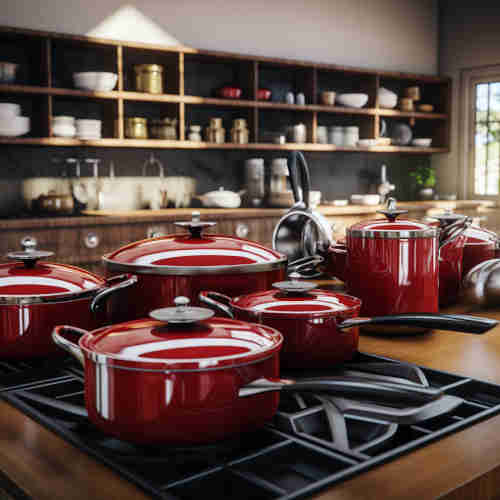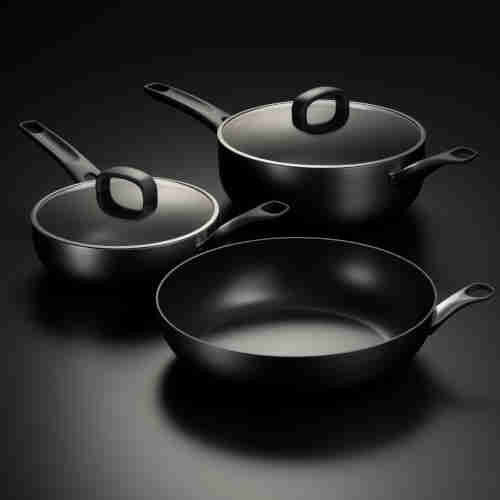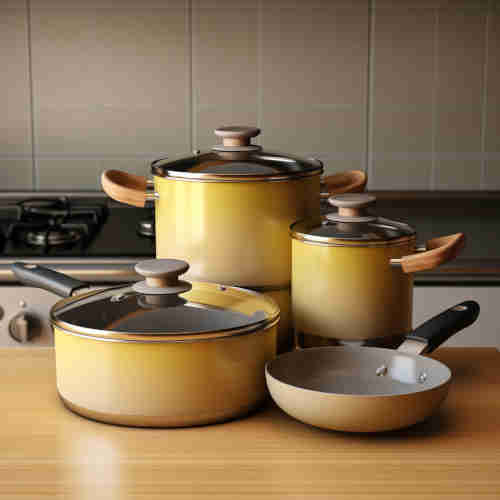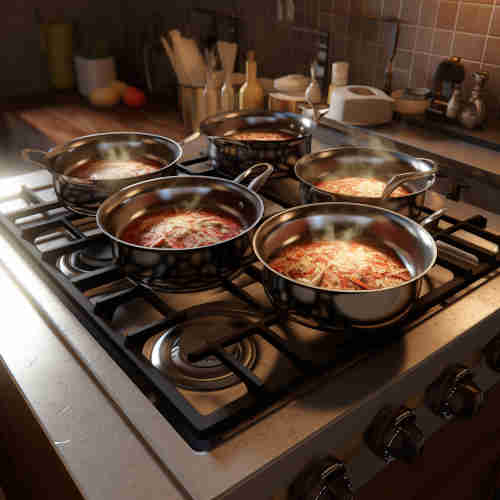Best Non Stick Cookware
Non-stick cookware has become increasingly popular in the past few decades for its convenience and ease of use in the kitchen. Not only does non-stick cookware eliminate the need for greasing and oiling surfaces, but it also eliminates the hassle of scrubbing off food residue and burnt-on messes. Non-stick cookware is also known for its durability, as it is made of materials such as aluminum, stainless steel, and ceramic that can withstand higher temperatures and resist scratches. With its many advantages, non-stick cookware is an ideal choice for the home chef who wants to enjoy the convenience and ease of cooking without the extra work.
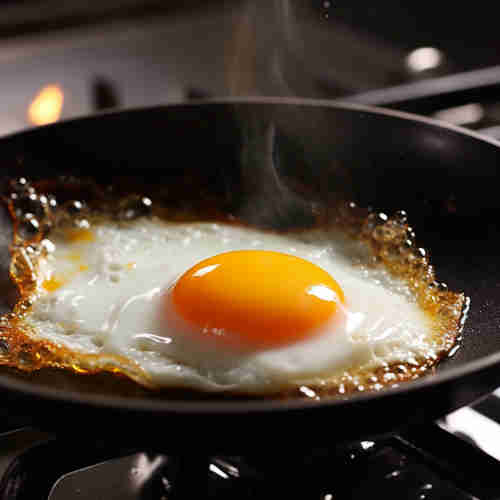
These are the best non stick cookware
10 Piece Cookware Set, Non-Toxic PFAS-Free Stainless Steel Ceramic Nonstick Coating, Induction Suitable, Pots, Pans Lids, Sauté & Saucepans, Multi Clad, Dishwasher & Oven Safe. The set includes 8” and 10” frypans, 1QT and 2QT saucepans with lids, 3QT sauté pan with lid, 5QT stock pot with lid, and Renew sponge. Free of PFAS, PFOA, lead, and cadmium for worry-free meals.
Why non stick cookware ?
Non-stick cookware has a number of advantages that make it a great choice for both home cooks and professional chefs. One of the biggest advantages of non-stick cookware is that it is very easy to clean. Even if food does stick to the surface, it will usually come off with just a little soapy water and a sponge. This is a big time saver, especially if you are cooking multiple dishes that need to be washed up afterwards. Another advantage of non-stick cookware is that it is generally very lightweight. This makes it easy to handle and manoeuvre, even when filled with food. Additionally, because non-stick cookware doesn’t need to be pre-heated as much as other types of cookware, it can save you time and energy in the kitchen.
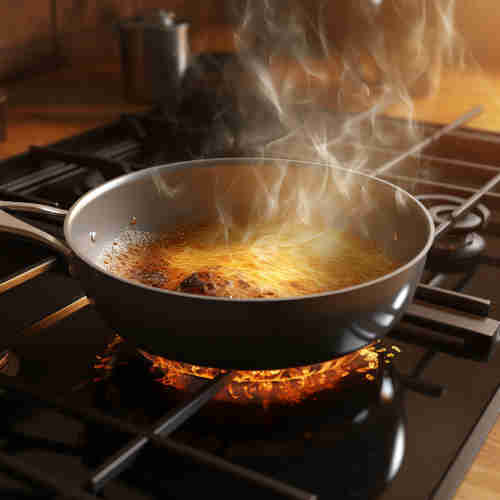
Different types of non stick surfaces
Nonstick cookware is made with a coating of polymer resin. This coating creates a barrier between the food and the cookware, preventing sticking. There are several different types of coatings, each with their own pros and cons. Some nonstick coatings are better than others.
Nonstick cookware is made with a coating of polymer resin. This coating creates a barrier between the food and the cookware, preventing sticking. There are several different types of coatings, each with their own pros and cons. Some nonstick coatings are better than others.
The best nonstick coatings are made with fluoropolymers, which are extraordinarily resistant to heat and scratching. This type of nonstick coating can last for years with proper care.
The most popular types of coatings are ceramic, Teflon, and silicone. Ceramic cookware is made from a type of clay that is fired at a high temperature. It is very smooth and non-porous, so it doesn't absorb flavors or odors. However, it is not as non-stick as Teflon and can be a bit more difficult to clean.
Ceramic coatings are generally considered the safest option, as they are free of harmful chemicals. However, they are not as durable as other types of coatings and can chip or scratch easily.
Teflon coatings are very durable and provide excellent non-stick properties. However, it is not very durable and can scratch easily. It can also release harmful chemicals if they are overheated.
Silicone coatings are a good middle ground between ceramic and Teflon. Silicone is made from a type of rubber that is heat-resistant. They are not only durable and provide good non-stick properties, they can also withstand high temperatures without releasing harmful chemicals. It is very flexible and non-stick. However, it can be a bit more difficult to clean than Teflon or ceramic.
Another type of non stick cookware is anodized aluminum. This type of cookware is much more durable than Teflon, but it is also more expensive. Anodized aluminum cookware is also not as smooth as Teflon, so it may not provide as good of non stick properties.
Aluminum cookware is another popular choice for many home cooks. Aluminum cookware is lightweight and has a natural non-stick surface. Aluminum cookware is also oven-safe and can be used on all types of cooktops, including induction cooktops.
Overview of non stick cookware
The most common type is the frying pan, but non-stick cookware also includes saucepans, sauté pans, stock pots, and Dutch ovens. The handles on the cookware are also important. They should be made of a material that will not get hot when the cookware is in use, so you can safely move it around while you're cooking. Stainless steel with plastic are good choices for handles. The final component of a non-stick cookware set is the lid. This is important for two reasons. First, it helps to keep the heat in while you're cooking. Second, it prevents splatters when you're cooking on the stovetop. Glass or stainless steel lids are good choices.
Food cooked in non stick cookware
There are many types of food that can be cooked in non stick cookware. Eggs and pancakes are two of the most popular breakfast items that can be cooked in a non stick pan. Omelets and frittatas can also be cooked in non stick cookware. For lunch or dinner, grilled cheese, sandwiches and quesadillas can be made in a non stick skillet.
Chicken, fish, and vegetables can all be cooked in a non stick pan. Non stick cookware is also great for making desserts like crepes, brownies, and cookies. Eggs and pancakes are two breakfast staples that can be cooked with ease in a non-stick pan.
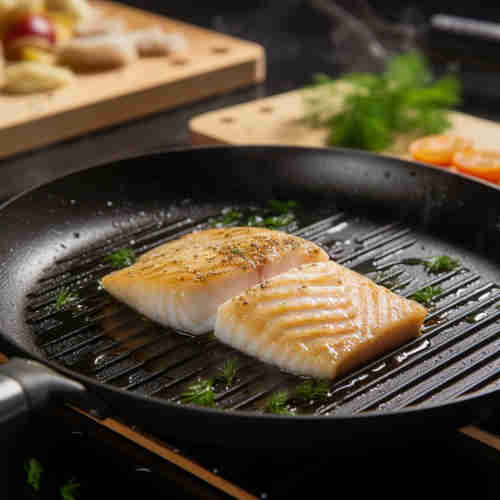
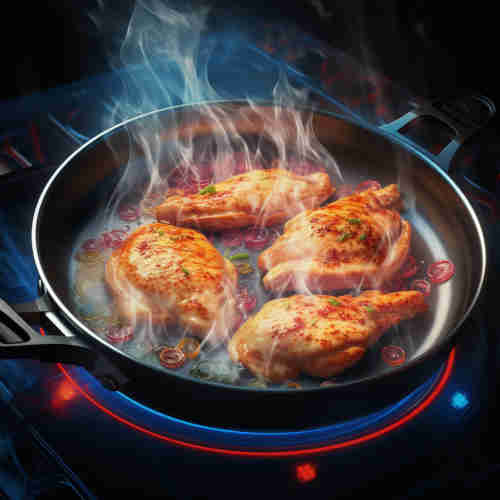
For lunch or dinner, grilled cheese sandwiches and quesadillas can be quickly made in a non-stick skillet. And when it comes to dessert, non-stick baking pans are perfect for making cakes, cookies, and brownies. cleanup is a breeze with non-stick cookware since there’s no need to scrub away burnt-on food.
Selection of non stick cookware
When choosing non-stick cookware, it is important to consider the material, the size and shape of the cookware, and the cooking surface. The material and the size and shape of the cookware will affect the cooking surface. The material will determine how well the cookware conducts heat.
Non-stick cookware is usually made from aluminum or stainless steel. Aluminum is an excellent conductor of heat, while stainless steel is a good conductor of heat.
Non-stick cookware comes in a variety of sizes and shapes. The size and shape of the cookware will determine the size of the cooking surface. The cooking surface is the most important factor to consider when choosing non-stick cookware. The cooking surface of a frying pan is usually larger than the cooking surface of a saucepan. The cooking surface should be smooth and even. The cooking surface should be able to withstand high temperatures.
Safety is another important factor to consider when choosing non-stick cookware. Some types of coatings can release harmful chemicals when they are overheated. If you are concerned about safety, look for cookware that is made with a ceramic or silicone coating.
Care for non stick cookware
Non-stick cookware is a kitchen staple for many home cooks. While it is convenient and easy to use, it does require some special care to keep it in good condition. Here are a few tips for taking care of your non-stick cookware:
- Avoid using metal utensils on your non-stick surfaces. Use wooden or plastic utensils instead to avoid scratching the surface.
- Don't use abrasive cleaners or scrubbers on your non-stick cookware. A soft sponge or cloth is all you need to clean it.
- Don't preheat your non-stick cookware before adding oil or food. This can cause the non-stick coating to break down over time.
- Be careful not to overheat your non-stick cookware. High temperatures can damage the non-stick coating. be sure to use only low or moderate heat when cooking with non-stick cookware.
- Non-stick cookware should never be heated empty - always add oil or cooking spray before adding food. Otherwise, the pan will be damaged.
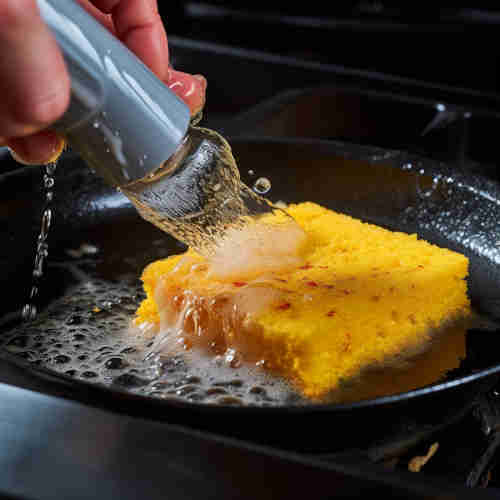
By following these simple tips, you can keep your non-stick cookware in good condition for many years to come.
Non-stick cookware is great for cooking foods that tend to stick to the pots and pan, such as eggs or pancakes. However, the non-stick coating can eventually wear off with use, and the pan may need to be replaced sooner than a stainless steel pan. Stainless steel cookware is more durable than non-stick cookware and can last a lifetime with proper care.
There are many benefits to using non stick stainless steel cookware. Perhaps the most obvious benefit is that it is easier to clean than traditional cookware. Non stick surfaces help to prevent food from sticking to the pot or pan, making cleanup a breeze.
In addition, non stick cookware is often dishwasher safe, making it even easier to keep your kitchen clean.
Another great benefit of non stick stainless steel cookware is that it is often more durable than other types of cookware. Stainless steel is a very strong material, and when combined with a non stick coating, it can withstand a lot of wear and tear. This makes non stick cookware a great choice for busy families or anyone who likes to cook often.
If you are looking for a new cookware set, consider choosing a non stick stainless steel set. You will be glad you did.
If you are looking for a new cookware set, you may want to consider a non stick aluminium set. These sets are becoming increasingly popular because they offer a number of advantages over other types of cookware.
Firstly, non stick aluminium cookware is very easy to clean. Because the surface is non stick, food debris will not stick to it and it can be easily wiped clean with a damp cloth.
Secondly, this type of cookware is very lightweight, making it easy to handle and maneuver.
Thirdly, non stick aluminium cookware heats up quickly and evenly, so you can cook your food more evenly.
Finally, many sets come with a variety of different sized pots and pans, so you can choose the right size for your needs. If you are looking for a new cookware set, a non stick aluminium set may be the right choice for you.
There are many different types of non stick aluminium cookware sets available on the market today. Each type has its own advantages and disadvantages, so it is important to choose the right set for your needs. The most common types of non stick cookware are:
- PTFE: This type of cookware is coated with a polymer called polytetrafluoroethylene, which is very slippery and resistant to sticking. PTFE cookware is very easy to clean and is often used for cooking delicate foods that might stick to other types of cookware. However, PTFE can be damaged by high heat, so it is not suitable for all types of cooking.
- PFOA: This type of cookware is coated with a polymer called perfluorooctanoic acid, which is even more slippery and resistant to sticking than PTFE. PFOA cookware is even easier to clean than PTFE cookware, but it is also more expensive.
- Ceramic: This type of cookware is coated with a ceramic material, which is non-stick and easy to clean. Ceramic cookware is often used for cooking delicate foods that might stick to other types of cookware. However, ceramic cookware can be damaged by high heat, so it is not suitable for all types of cooking.
If you're in the market for non-stick cookware, you may be wondering if a cast iron set is the right choice for you. Here's what you need to know about cast iron cookware sets:
- Cast iron is a material that has been used for centuries to create cookware and other products. It is known for its durability and ability to retain heat, making it an ideal choice for cookware. It can last for decades with proper care.
- Cast iron is an excellent conductor of heat. This means that it heats evenly, which is ideal for cooking. Cast iron cookware can be used on any type of stove, including induction cooktops.
Cast iron cookware sets usually come with a few key pieces, like a frying pan, a Dutch oven, and a grill pan. Cast iron can be found in a variety of cookware sets, including non-stick options. Non-stick cookware sets that include cast iron pieces are a great option for those who want the benefits of cast iron without the hassle of seasoning and maintaining the pan. These sets typically include a skillet, saucepan, and Dutch oven, all of which have a non-stick coating of Teflon, ceramic, silicone or enamelled cast iron that makes cooking and cleanup a breeze. If you're looking for a non-stick cookware set that will last a lifetime, a cast iron set is a great option.
Porcelain non stick cookware is one of the best kinds of cookware you can buy. Porcelain non stick cookware is a type of cookware that is made from a material called porcelain. This type of cookware has many advantages over other types of cookware.
One advantage of porcelain non stick cookware is that it is very durable. This type of cookware can last for many years if it is properly cared for. Another advantage of porcelain non stick cookware is that it is very easy to clean. This type of cookware does not require any special cleaners or scrubbers. You can simply wipe it clean with a damp cloth. Finally, porcelain non stick cookware is very safe to use. This type of cookware is made with a material that is not poisonous and will not release any harmful chemicals into your food.
Porcelain non stick cookware comes in many different forms. The most common type is the frying pan. Frying pans come in a variety of sizes, but the most common size is the 8-inch frying pan. Frying pans are used for a variety of tasks, such as frying eggs, bacon, and sausage. They can also be used for sautéing vegetables or making a grilled cheese sandwich.
Another type of porcelain non stick cookware is the saucepan. Saucepans are usually smaller than frying pans and have straight sides. They are used for tasks such as boiling water or making soup. Saucepans come in a variety of sizes, but the most common size is the 2-quart saucepan.
The last type of porcelain non stick cookware is the roasting pan. Roasting pans are large, rectangular pans with deep sides. They are used for tasks such as roasting a chicken or a turkey. Roasting pans come in a variety of sizes, but the most common size is the 16-inch roasting pan.
There are many different types of non stick cookware for gas stoves. Some of the most common include pots and pans made from materials such as aluminum, stainless steel, or cast iron. Each type of cookware has its own benefits and drawbacks, so it is important to choose the right one for your needs.
Aluminum cookware is lightweight and easy to handle, making it a good choice for those who are new to cooking with gas. It is also a good conductor of heat, meaning that food will cook evenly. However, aluminum is a soft metal and can be easily scratched or dented.
Stainless steel cookware is more durable than aluminum and is less likely to be damaged. It is also a good conductor of heat, but not as good as aluminum. Stainless steel can also be more difficult to clean than other types of cookware.
Cast iron cookware is very durable and is perfect for those who do a lot of cooking. It is an excellent conductor of heat, meaning that food will cook evenly. However, cast iron is very heavy and can be difficult to lift. It is also susceptible to rust if it is not properly cared for.
There are many types of non stick coating on the cookware for gas stoves. The most popular type is the Teflon coated pan. These pans are coated with a chemical called polytetrafluoroethylene, or PTFE. This chemical is very slippery, and it prevents food from sticking to the pan. Teflon pans are very popular because they are very easy to use and clean. However, some people are concerned about the safety of Teflon. Some studies have shown that when Teflon is heated to high temperatures, it can release harmful chemicals into the air. If you are concerned about the safety of Teflon, you can choose to use another type of non stick cookware.
Ceramic coated pans are another popular option. These pans are coated with a ceramic material that is also very slippery. Ceramic pans are safe to use and are also easy to clean. However, they are not as durable as Teflon pans and can scratch easily. If you are looking for a durable option, you can choose to use a stainless steel pan. Stainless steel pans are not coated with anything, so they are not as slippery as other types of pans. However, they are very durable and can last for many years.
Best cooking recipes
Enjoy cooking with hundreds of great Southern Living recipes here.
Here are the 99 most American Recipes Ever.
If you like to cook Europeans, check this out.

